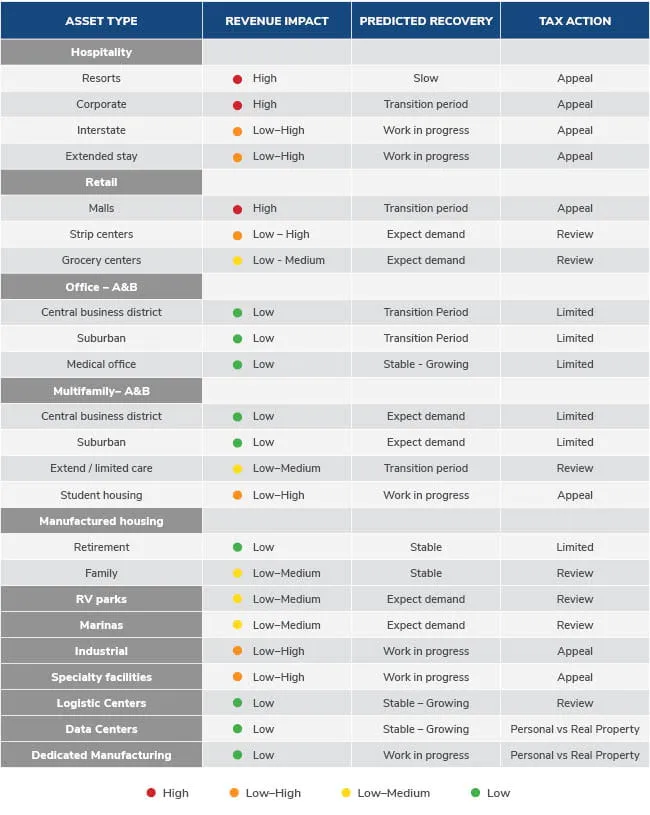
The COVID-19 pandemic initially caused broad expectations of an industrywide recession that failed to materialize. Instead of markets repricing assets based on distress, various market forces kept pricing and demand high for most asset types. Performance, on the other hand, did not necessarily correlate with pricing. The most dominant factor has been the availability of capital, including abundant financing, new and old investors ready to spend and willingness of existing lenders to pretend and extend.
Market-driven demand by end space users continues to evolve. The predictions of flipping the switch and returning to the old normal are not going to happen as readily as many journalists predict. COVID-19 may have new forms, and we may be facing multiple cycles of disruption. Other factors in motion include establishing the new normal, what and how will end users’ demands on their real estate use change, imbalances in supply and demand, and inflation’s looming impact on financing/capital, pricing of assets, jobs and new construction to name a few. Put this in the context of a time of historical political uncertainty and the opportunity of the unexpected increases.
In the property tax assessment community, because property valuations are determined as dictated by legislated mandated dates, there were minimal reduction opportunities in 2020. The most common state valuation date is January 1, so there were minimal quantifiable issues in 2020 as it did not reflect the impact of COVID-19 on local real estate values. The real opportunity began in 2021 because the impact was present and quantifiable for many assets as of the January 1, 2021, valuation date.
Out in the real estate markets, a new phenomenon appeared national that was previously concentrated in retirement destinations. As the workforce began to operate from home, and home could be anywhere, there was a massive shift in demand for single family housing (SFH). Prices skyrocketed, often double digits, across the U.S., with media stories of bidding wars and sight unseen buyers.
Discussions of mass employee/employer migrations, better working conditions, permanent work from home, relocation out of high-tax states and different ways to meet new consumer needs filled the media. Naturally, combined with supply chain issues, the sudden demand created a dearth of housing options and an explosion of construction costs. The SFH building industry was already historically lagging demand before COVID-19, and some are predicting up to two-three years to catch up.
Assessors reacted differently to this new and unexpected increase in SFH. Some advocated no change in SFH values, while others increased values at a fractional percentage of the actual SFH market growth, or worse, took the SFH appreciation rates and applied them to all other tax base property types. A few took the step to decrease housing valuations as they misread the market or attempted to manage property tax shifts between asset classes. Today, it is clear SFH has increased in value faster than any other component of the tax base. The proof is in the number of new investment funds targeting pools of SFH for acquisition.
Starting in 2021 and 2022, or as local revaluation occurs, we anticipate seeing SFH tax assessments shift to higher values and become a larger percentage of the tax base as a class. That means taxes should be coming down for the next few years looking only at values. Some jurisdictions that follow longer revaluation cycles of four, six or eight years will delay the right sizing of the tax base, benefiting SFH at the expense of other classes. That is not uncommon as some jurisdictions allow assessors' discretion in setting revaluation years.
A local revalue should shift the tax base allocation to all other types, including office, retail, industrial and multifamily properties, as other real property assets are not experiencing the same inflation of values, especially for retail and hospitality.
Lurking within this revaluation promise of lower taxable market values is the threat of increased tax rates as jurisdictions seek to address unfunded legacy costs and new projects. Already there are stories of federal relief funds not being applied to reduce these costs, which will pressure future increases in tax rates.
COVID-19 Impact on Taxable Market Values by Asset Type

This chart is intended for readers to quickly identify their property types and see guidance on COVID-19 and tax-related appeals. There are always property nuances that override these simplifications.
In all COVID-19 discussions, the jurisdictions will want to see the proof of impact on valuation. Many properties will not qualify for valuation reductions. Some owners may find that they incurred costs and losses but are still undervalued. Jurisdictions believing COVID-19 is over is common. Be prepared to address questions such as: How costs and occupancies were impacted? What is this asset’s position in the market? Review asset-specific income (actual or market) and rent rolls for changes in rent and occupancy costs and evaluate recent market sales and asset performance in the market.
The Duff & Phelps, A Kroll Business, tax team can identify tax-reduction strategies for all types of properties. These are atypical times, and the skill and experience of your advisors is critical in managing your largest operating expense. Use the Duff & Phelps COVID-19 Property Tax Map to track COVID-19 tax legislations and state nuances. In the meantime, please reach out to your property tax advisor with any questions related to commercial property tax assessments.
